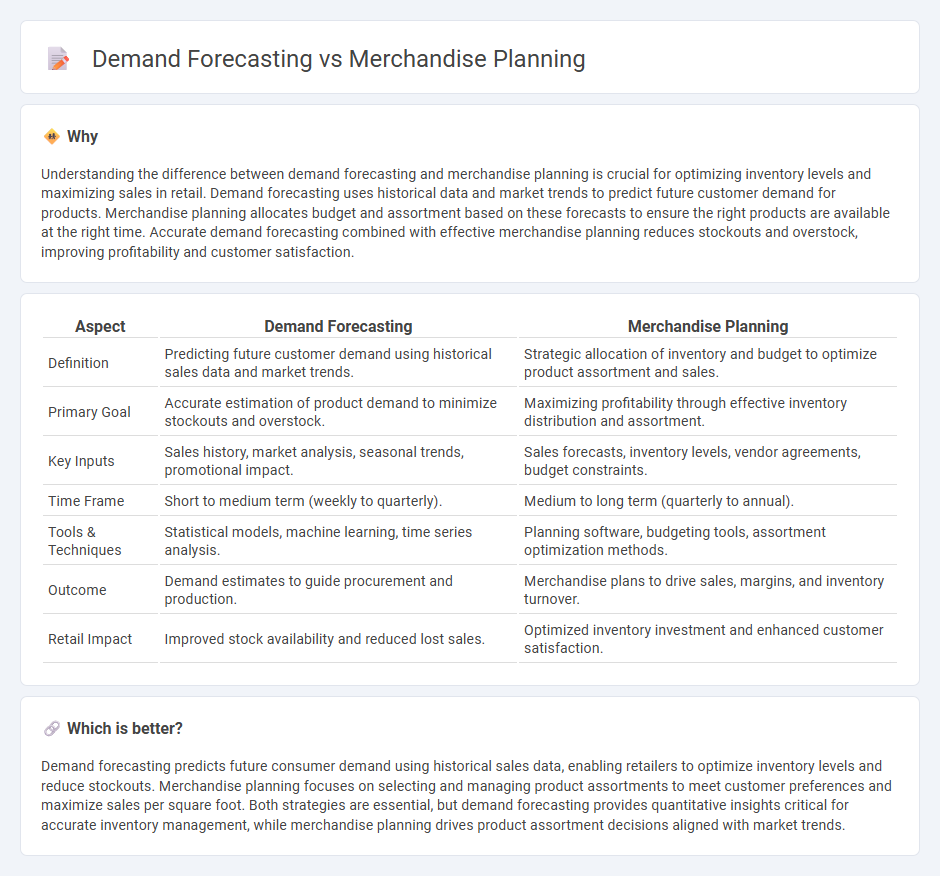
Demand forecasting predicts future customer demand by analyzing historical sales data, market trends, and consumer behavior to optimize inventory levels. Merchandise planning focuses on selecting the right mix of products, quantities, and pricing strategies to maximize sales and profitability in retail operations. Explore more about how demand forecasting and merchandise planning drive efficient inventory management and boost retail success.
Why it is important
Understanding the difference between demand forecasting and merchandise planning is crucial for optimizing inventory levels and maximizing sales in retail. Demand forecasting uses historical data and market trends to predict future customer demand for products. Merchandise planning allocates budget and assortment based on these forecasts to ensure the right products are available at the right time. Accurate demand forecasting combined with effective merchandise planning reduces stockouts and overstock, improving profitability and customer satisfaction.
Comparison Table
| Aspect | Demand Forecasting | Merchandise Planning |
|---|---|---|
| Definition | Predicting future customer demand using historical sales data and market trends. | Strategic allocation of inventory and budget to optimize product assortment and sales. |
| Primary Goal | Accurate estimation of product demand to minimize stockouts and overstock. | Maximizing profitability through effective inventory distribution and assortment. |
| Key Inputs | Sales history, market analysis, seasonal trends, promotional impact. | Sales forecasts, inventory levels, vendor agreements, budget constraints. |
| Time Frame | Short to medium term (weekly to quarterly). | Medium to long term (quarterly to annual). |
| Tools & Techniques | Statistical models, machine learning, time series analysis. | Planning software, budgeting tools, assortment optimization methods. |
| Outcome | Demand estimates to guide procurement and production. | Merchandise plans to drive sales, margins, and inventory turnover. |
| Retail Impact | Improved stock availability and reduced lost sales. | Optimized inventory investment and enhanced customer satisfaction. |
Which is better?
Demand forecasting predicts future consumer demand using historical sales data, enabling retailers to optimize inventory levels and reduce stockouts. Merchandise planning focuses on selecting and managing product assortments to meet customer preferences and maximize sales per square foot. Both strategies are essential, but demand forecasting provides quantitative insights critical for accurate inventory management, while merchandise planning drives product assortment decisions aligned with market trends.
Connection
Demand forecasting uses historical sales data, market trends, and consumer behavior analytics to predict future product demand, directly influencing merchandise planning decisions. Accurate demand forecasts enable retailers to optimize inventory levels, select appropriate product assortments, and allocate resources efficiently. Integrating these processes minimizes stockouts and overstock situations, enhancing profitability and customer satisfaction.
Key Terms
Assortment Planning
Merchandise planning involves strategizing product assortment, pricing, and inventory to maximize sales and profitability, while demand forecasting predicts future customer demand using historical data and market analysis. Assortment planning, a critical component of merchandise planning, uses demand forecasts to determine the optimal mix of products to stock, aligning inventory with consumer preferences and trends. Explore how integrating advanced forecasting techniques enhances assortment planning for better inventory turnover and customer satisfaction.
Inventory Management
Merchandise planning optimizes inventory allocation by analyzing sales trends, seasonality, and product lifecycle to maximize profitability and reduce stockouts or overstock situations. Demand forecasting predicts future customer demand using historical sales data, market analysis, and predictive analytics to enhance inventory accuracy and minimize carrying costs. Explore in-depth strategies to balance merchandise planning and demand forecasting for effective inventory management.
Sales Prediction
Merchandise planning involves strategizing product assortment and inventory levels based on sales forecasts and market trends, while demand forecasting specifically predicts future sales to guide inventory and production decisions. Accurate sales prediction enhances merchandise planning by aligning stock availability with consumer demand, optimizing turnover rates and reducing markdowns. Explore further to understand how integrating sales prediction refines retail strategies and maximizes profitability.
Source and External Links
What Is Merchandise Planning? Elements and Process (2025) - Merchandise planning is a systematic approach to planning, buying, and selling merchandise based on consumer demand, involving post-season analysis, pre-season planning, and in-season adjusting to optimize inventory and sales performance for different product types and seasons.
How to create an effective retail merchandise plan - QuickBooks - Intuit - Merchandise planning is a high-level overview for the upcoming season using past sales data and trend analysis, distinct from assortment planning, and involves analyzing past sales, forecasting demand, budgeting, timing, and allocating inventory accordingly.
Merchandise Planning: Retail Strategies for Success - Anaplan - Effective merchandise planning addresses the four Ws: what to sell, when to sell, where to sell, and who to sell to, integrating product strategy, cross-channel strategy, and customer strategy (merchandise planning 3.0) to create balance between consumer experience, inventory, and market needs for retail success.
 dowidth.com
dowidth.com